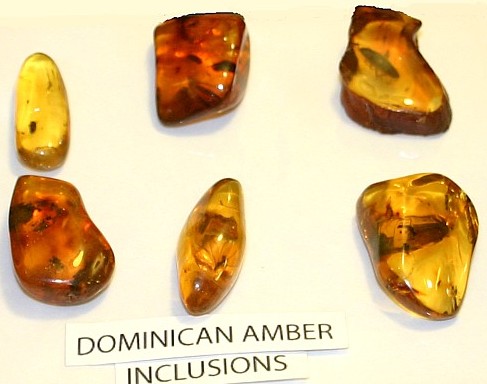|
.
Amber
Mineral Facts:
Chemical
Formula: Petrified tree resin (organic)
Amber has a composition
corresponds roughly to the formula C10H160, but it is
really incorrect to ascribe to it a formula, since it
consists of a mixture of organic compounds. It differs from various other
and less important amber-like substances in containing a small amount, on
the average about 4 percent succinic acid.
Colors:
pale yellow to golden to
red to brownish.
Hardness:
2.5
Density:
1.1
Density is variable based on chemical make up and amounts of impurities.
Cleavage:
There is no cleavage,
it has a conchoidal fracture.
Crystallography: Amorphous
Luster:.
Resinous luster.
Optics:
(Refractive Index):
= 1.54 |

Amber with insect inclusions |
|
Composition, Structure and
Associated Minerals:
Amber or
succinite is a fossilized tree resin.
It consists of the hardened
resinous remains of the pitch from conifer trees, mostly Pinus succinifer,
now extinct.
It occurs in
the form of rounded pieces
of variable sizes in different types of
sedimentary rocks
where the resin has been preserved and refined through a mild level of
natural heat and pressure. This mild level of heat and pressure polymerizes
the organic molecules in the resin to a harder more durable, plastic like
substance.
The Baltic amber of modern
jewelry commerce is obtained chiefly from the north-west Samland coast of
the Baltic, in Poland, in the area around Gadansk, most notably at the Anna
mine near Palmnicken, which is the centre of an important amber mining
industry. The amber occurs in beds of glauconitic sand and loam of Lower
Oligocene age. It is found in the form of rounded pieces that vary from the
size of a pea up to about 15 Ib. in weight, though pieces so large are rare.
The smaller pieces are of little value in their natural state, but they are
heated and compressed into larger blocks of material that is distinguished
from the natural amber by the name "amberoid" ("ambroid") or "pressed
amber." Amberoid is less valuable than the natural product. It is stated
that the cloudy effects often seen in natural amber can be produced in
amberoid. Lower class amber products are found around the world in many
sedimentary environments. An amber-like material known as burmite
occurs and is worked to a small extent in the Hukong valley, Upper Burma.
Burmite differs from ordinary amber in containing no succinic acid. Also
closely similar to amber in their nature, occurrence, and mode of origin are
copalite (fossil resin), which occurs abundantly in the surface gravels of
Tanganyika Territory; and Kauri resin, which is found abundantly in New
Zealand. Copalite is a generic term used for
organic resins that are not old enough to have polymerized sufficiently to
become amber.
Identification
and Diagnostics
Amber is very
brittle. When rubbed it does not become sticky, but, owing to the fact that
it is an extremely bad conductor, it becomes
strongly electrified with a static charge. The word "electricity" is derived
from electron, which is the Greek name for amber.
Amber Uses:
Amber has been used by man for more than 13,000
years, having been collected and valued since the stone age, long ago.
Amber has been used since antiquity in the manufacture
of jewelry, amulets and other ornaments, and also in folk medicine. Amber
has long been used in folk medicine for its purported healing properties.
Amber and extracts were used from the time of the ancient Greeks for a wide
variety of treatments. It was also popular as a medical treatment through
the Middle Ages. Though
amber figures as a minor gemstone, it is used chiefly in the manufacture of
beads, and occasionally for the purpose of mouthpieces of pipes and
cigarette holders. It is also used in the manufacture of amber varnish or
colophony.
.Return
to the
Mineral Collectors Information Page |
|


